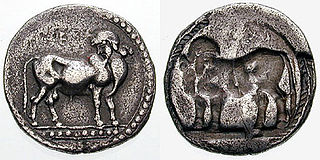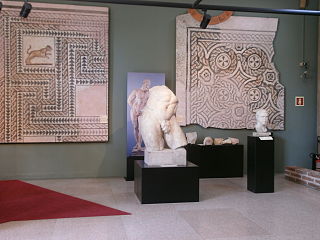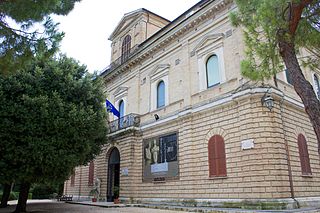
Adria is a town and comune in the province of Rovigo in the Veneto region of northern Italy, situated between the mouths of the rivers Adige and Po. The remains of the Etruscan city of Atria or Hatria are to be found below the modern city, three to four metres below the current level. Adria and Spina were the Etruscan ports and depots for Felsina. Adria may have given its name during an early period to the Adriatic Sea, to which it was connected by channels.

The National Archaeological Museum of Naples is an important Italian archaeological museum, particularly for ancient Roman remains. Its collection includes works from Greek, Roman and Renaissance times, and especially Roman artifacts from the nearby Pompeii, Stabiae and Herculaneum sites. From 1816 to 1861, it was known as Real Museo Borbonico.

Altinum was an ancient town of the Veneti 15 km SE of modern Treviso, close to the mainland shore of the Lagoon of Venice. It was also close to the mouths of the rivers Dese, Zero and Sile. A flourishing port and trading centre during the Roman period, it was destroyed by Attila the Hun in 452. The town recovered, but was later abandoned when sea-borne sand began to cover it over. Its inhabitants moved to Torcello and other islands of the northern part of the lagoon.

The Sile is a 95 km river in the Veneto region in north-eastern Italy. Its springs are in the municipality of Vedelago in the Province of Treviso. It flows into the northern part of the Lagoon of Venice at the mouth of the River Piave Vecchia. It receives the waters of its tributary, the Botteniga, at Treviso.

The National Roman Museum is a museum, with several branches in separate buildings throughout the city of Rome, Italy. It shows exhibits from the pre- and early history of Rome, with a focus on archaeological findings from the period of Ancient Rome.

Quarto d'Altino is a town in the Metropolitan City of Venice, Veneto, Italy. SP41 provincial road goes through it.

Laüs or Laus was an ancient city of Magna Graecia on the coast of the Tyrrhenian Sea. It was a colony of Sybaris at the mouth of the Lao River, which formed the boundary between Lucania and Bruttium in ancient times. The river and the city have the same name in Ancient Greek. Today the archaeological site of the city can be found at a short distance to the east of Marcellina, a frazione of the comune of Santa Maria del Cedro in Calabria.
The Via Annia was the Roman road in Venetia in north-eastern Italy. It run on the low plains of the lower River Po and of the lower Veneto and Friuli Venezia Giulia regions, an area which had many rivers and large marsh areas and bordered the coastal lagoons. It linked Atria to Aquileia, passing through Patavium. Then it got to the mainland coast of the Lagoon of Venice near today's Mestre and passed through Altinum. After this, it went through Iulia Concordia, which was further inland. It was paved only through the main towns. The rest was gravelled. It was six to eighteen metre wide. It played an important part in the Romanization of the region.

The Museo Nazionale della Magna Grecia, Museo Archeologico Nazionale di Reggio Calabria or Palazzo Piacentini is a museum in Reggio Calabria, southern Italy, housing an archaeological collection from sites in Magna Graecia.
The archaeological area of Poggio del Molino is situated on the northern side of a headland that acts as a watershed between the beach of Rimigliano in the north, and the Gulf of Baratti in the south; to the northern border of the territory administered by the city of Piombino in the Italian Province of Livorno. The structure of Roman age spreads over a high plateau of about 20 m asl which dominates, in the west, the stretch of a sea between San Vincenzo and Elba and to the east, the metalliferous hills and plains of the Campiglia lagoon. The top of the hill is occupied by the beautiful Villa del Barone, built in 1923 by Baron Luigi De Stefano and Assunta Vanni Desideri, the daughter of Eugenio. From a paper of the 16th century, the "Bandita di Porto Baratti", and some archival documents we know that the Poggio owes its name to the mill which was a part of Torre Nuova, the building of coastal defense and a lookout built in the early sixteenth century by Cosimo I de' Medici, on the slopes of the promontory.

The Provincial Museum of Torcello is a museum founded at the end of 19th century on the Venetian island of Torcello. It has two sections: the Archaeological Section and the Medieval and Modern Section.

The Archaeological Museum of Milan is located in the ex-convent of the Monastero Maggiore, alongside the ancient church of San Maurizio al Monastero Maggiore, with entrance on Corso Magenta.

The National Archaeological Museum is a museum located right on Piazza San Marco in Venice.

The Archaeological Museum of Savona is located in Palazzo della Loggia inside the Priamar Fortress. It presents the history of the Priamar promontory and the town of Savona. On the exposition are old collections of objects from around the Mediterranean and artifacts from the 20th century excavations of the fortress and its surrounding. The museum has two floors and inside it is possible to see original excavation pits.

The Museo Archeologico Regionale Paolo Orsi of Syracuse, Sicily is one of the principal archaeological museums of Europe.

Museo Archeologico Nazionale d'Abruzzo is an archaeology museum in Chieti, Abruzzo.

The stele of Isola Vicentina is an ancient prehistoric artefact found in the municipality of Isola Vicentina.

The Giorgio Asproni National Archaeological Museum is an archaeological museum in the historic centre of Nuoro, in Sardinia, near the Cathedral of Our Lady of the Snows. Established in 2002, it is located in a nineteenth-century building that belonged to Giorgio Asproni, a Sardinian politician and intellectual of that era.

The Jatta National Archaeological Museum in Ruvo di Puglia, a historic city in southern Italy, was set up in rooms of Palazzo Jatta and represents the only example in Italy of a nineteenth-century private collection that has remained unaltered from the original museographic concept. The finds preserved in the museum were collected by the archaeologist Giovanni Jatta in the early nineteenth century and his collection was subsequently enriched by his nephew of the same name and was sold to the Italian state in the twentieth century.































